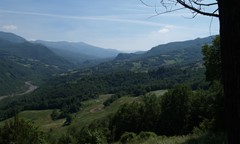Palagano.
Excursions to the Cinghi di Boccassuolo mines in the Val Dragone
Near Palagano, in the midst of stunning, untamed nature, a pleasant stroll takes us to the Cinghi di Boccassuolo mines, still the source of far-fetched stories about the alleged presence of gold. The mines started working as far back as 1343, when Guglielmino da Montecuccolo signed a contract with some labourers for works to be done in the area between Medola and Boccassuolo to seek “precious materials” which, unhappily, only led to the finding of copper and lead.
After many ups and downs, we have no more news of the mining activity in this area until, in the years 1631 and 1632, there are reports of consistent discoveries of copper during the excavations. Only in 1699 was explicit reference made to the quarries on the Boccassuolo and Toggiano hillside with quite precise details.
We have no more news of the mine’s activity after 1788 when extraction of the metals stopped being profitable. From a recent campaign of research and exploration at the mines, twelve galleries have been found extending well over 1,300 metres: four following the northern slope of the Cinghio del Corvo, at 1,079m above sea level, and eight downhill from the Palagano Boccassuolo local road.
Some of the mines may be visited, such as the one at Toggiano which, while certainly minor in terms of development compared to the others, does display all the main characteristics of the mining activity carried out over time. In fact, unlike all the others, it has an entrance portal that is still intact while inside the copper is clearly visible. In addition, substantial formations of calcium carbonate can be seen, with hints of stalactites. At the end of the mine is a “well” with crystal clear water, inside which may be seen the old containment beams.
